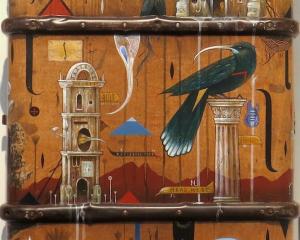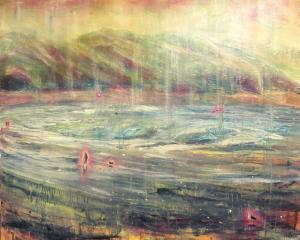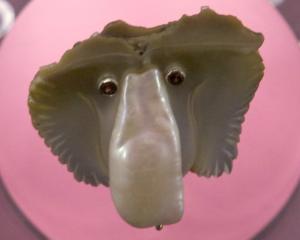"Slice", Chris Weaver (Brett McDowell Gallery)
Chris Weaver presents a series of functional, elegant ceramics in his exhibition "Slice" at the Brett McDowell Gallery.
Weaver's tableware displays a clean simplicity, simultaneously warm yet austere.
His teapots and platters make use of a gently tapered rectilinear form, subtly softened by curved edges and rims.
The works are primarily influenced by Victoriana, and the use of deep bluish-black also harks back to the sootiness associated with kettles and teapots from an earlier age.
The stark yet effective use of solid plain white and iron-black surfaces also lends the works a strong oriental edge.
Other pieces have a more organic feel, the surface ripples and pale green-grey reflecting the vein patterns of leaves.
These pieces may well denote the influence and inspiration the artist finds in his working location on the West Coast.
The additional use of bowed rimu in several of the pieces also reflects the natural surroundings near Weaver's home.
There is stone-like solidity to the pieces, yet at the same time it is the comfortable feel of stones which have been worn smooth by the tide or water's current.
The soft yet simple lines of the works makes them attractive to both the eye and the curve of the hand.
"Winter exhibition", (Bellamys Gallery)
Bellamys gallery's winter exhibition is a showcase for four artists three of them Bellamys.
The one interloper is Ewan McDougall, who presents several of his bright, gleeful crowd scenes, the faces grinning maniacally from the canvas.
Of these, it is the Matisse-meets-Ivan Hill whimsy of Einstein, Monroe and Tremain on Broad Bay Beach which leaves the most lasting impression.
The three Bellamy family members exhibiting are Pauline Bellamy and sons Max Bellamy and Manu Berry.
Pauline's work consists of several etchings and oils, of which the most notable is a painting of the old stables at St Bathans.
The artist has well captured the solidity of the building, which seems to loom from the canvas.
Max Bellamy has presented just three works, the most impressive of which is the white-on-white woodcut Ineffability.
Manu Berry's move to the Wellington harbour shoreline has seen the artist captivated by the play of light on rippling water, something he uses to great effect in the four-panelled Shimmer.
This work, though, is but an appetiser for the show-stealing mixed-media work Lamp Black.
The work's carved relief is lacquered to a shiny blackness and lit from below to simulate crepuscular light playing across water and land.
This impressive piece may be an indication of a new direction in the career of a fine young artist.
"The Landless", Joanna Langford (Dunedin Public Art Gallery)
Joanna Langford has created a topographical structure in her latest work at the Dunedin Public Art Gallery.
"The Landless" is a framework constructed from disassembled clothes airers and artificial vegetation garnishes.
Small motors leave the greenery in constant motion, with individual sections slowly rotating within the frame.
The resulting work is simultaneously natural and artificial in implication, the bare polyhedra of an open hillside lying beneath the towering pinnacles of some never-built cityscape.
The impression gained is of a metropolis whose residents have expanded their constructions to build artificial fields on the city's fringes, floating precariously above the void on spindly legs.
The terraforming rests on the flimsiest of supports, and one gets the impression that the structure could easily collapse at any moment.
The intended message has been left unstated for the interpretation of the viewer.
To my mind, it may be an allegorical comment on the human race's impressive ability to build mighty cities while simultaneously leaving the earth on which they stand in a more and more perilously fragile state.
The eight-legged green structure also simultaneously suggests of the shape and form of a giant spider guarding its fragile home.




![... we all become all of these things [installation view] (2025), by Megan Brady.](https://www.odt.co.nz/sites/default/files/styles/odt_landscape_small_related_stories/public/story/2025/03/1_we_all_become_all_of_thes.jpg?itok=nicA_yAm)


![Poipoia te Kākano [installation view]. Allison Beck, Megan Brady, Kate Stevens West, Jess...](https://www.odt.co.nz/sites/default/files/styles/odt_landscape_small_related_stories/public/story/2025/02/1_poipoia_te_k_kano.jpg?itok=ssJ8nxyx)




